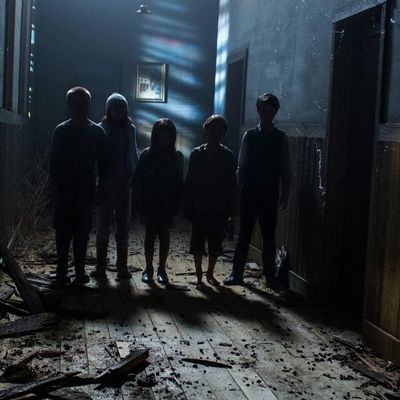
The biggest scare in Sinister 2 comes not from a demon appearing in the darkness, or a creepy ghost-kid materializing out of nowhere ÔÇö though the movie does have plenty of those, too ÔÇö but from an abusive father blowing up at his terrified son. ItÔÇÖs a moment of real horror amid the movieÔÇÖs many phantoms, and it gets to the heart of why this sequel, as rough as it is, might be more worthwhile than its 2012 original.
The first Sinister, directed by Scott Derrickson from a screenplay by C. Robert Cargill, was a case-study in cinematic sadism. It focused on the breathless investigations of true-crime author Ethan Hawke as he looked into the mysterious filmed deaths of a series of families, and its gee-whiz portrayals of anonymous children and parents getting elaborately murdered ÔÇö usually presented via 8mm home movies ÔÇö had no sense of loss, and thus, no real horror. (ThereÔÇÖs a difference between ÔÇ£scaresÔÇØ and ÔÇ£horror.ÔÇØ) The film avoided using its heroÔÇÖs family as anything other than jump-scare fodder, so that by the time the climax rolled around ÔÇö the daughter, under the spell of an ancient demon called Bughuul (or Mr. Boogie, or the bogeyman), chopped up her entire family ÔÇö the overall feeling was one of numbness, exhaustion, and disgust. Maybe it was all intentional? Bughuul lived in a purely iconographic realm; he was literally inside the movie screen, so that watching the filmed murders unleashed him ÔÇö a meta-twist that almost conceded the movieÔÇÖs very heartlessness.
Sinister 2, directed by Ciaran Foy (who made a terrifically bleak low-budget Irish horror flick called Citadel several years ago) and written by Derrickson and Cargill, feels almost like a correction to the earlier film. It grounds itself not in investigations and mythology but in people. This time, the protagonists are a desperate family on the run: Courtney (Shannyn Sossamon) has left her abusive husband and is hiding out, along with her twin 9-year-old sons Dylan (Robert Daniel Sloan) and Zach (Dartanian Sloan), in a rambling house where one of these ghastly murders previously occurred. ThatÔÇÖs how they hook up with the sheriffÔÇÖs deputy from the first film (James Ransone), who had helped out with the investigation and has now set about burning down the houses where these crimes happened before anyone else can inhabit them. He canÔÇÖt burn down this one, however, while Courtney and her kids are there, especially since he knows that the family always gets murdered as soon as they move out.
But the real dilemma at the center of Sinister 2 concerns the boys themselves. Dylan and Zach have already made contact with a gathering of ghost kids in service to Bughuul and are in the process of being seduced to join their ranks ÔÇö particularly the much-bullied and sensitive Dylan. The film spends an admirable amount of time dwelling on the twinsÔÇÖ torn inner states, and on how resentment, fear, and jealousy can be twisted into murderous compulsion. Back when the first Sinister was released, my colleague David Edelstein astutely pointed out that it lacked ÔÇ£what once mattered most in tales of madness and the supernatural: the metaphor for human experience (the dark side, obviously) that canÔÇÖt be captured through mere photographic realism.ÔÇØ So, now, here it is: a conflict thatÔÇÖs relevant and resonant, not just convenient, and that makes you genuinely invested in the outcome of the film.
One wishes, however, that Sinister 2 were more effective in other ways. Not all of it makes sense; thereÔÇÖs some further delving into the myth of Bughuul via a ham-radio transmission from the 1970s, called the ÔÇ£Norwegian hell call,ÔÇØ which is nice and spooky but is dropped as soon as itÔÇÖs introduced. The film relies on a lot of big jump-scares, but theyÔÇÖre not deployed with the kind of slickness Derrickson brought to the first one. (Even though, as noted earlier, Sinister 2 does a better job of actually earning its more honest scares.) And hardworking character actor Ransone, with his dancing eyebrows and overzealous delivery, is fundamentally a scenery-chewer, but totally wrong for the part of savior-hero ex-cop. (HeÔÇÖs much better-utilized in the recent indie hit Tangerine, playing a duplicitous pimp.)
But again, Sinister 2 has heart ÔÇö which is a weird thing to say about a movie in which one family is eaten alive by rats ÔÇö and that makes a difference. A pall of regret hangs over the whole thing. In the flickering, filmed chronicles of the ghost childrenÔÇÖs past crimes, the pleasant portraits of family togetherness that always precede the murders have a staged quality; these hoped-for idylls are, both literally and figuratively, projections. One sensed this briefly in the first film, too, but there, Derrickson and Cargill seemed almost consciously to avoid playing with that conceit. This time, they and Foy not only acknowledge the idea, they use it to build suspense and emotional urgency. Sinister 2 is far from perfect, but it has a nobility thatÔÇÖs rare in much modern horror cinema.


